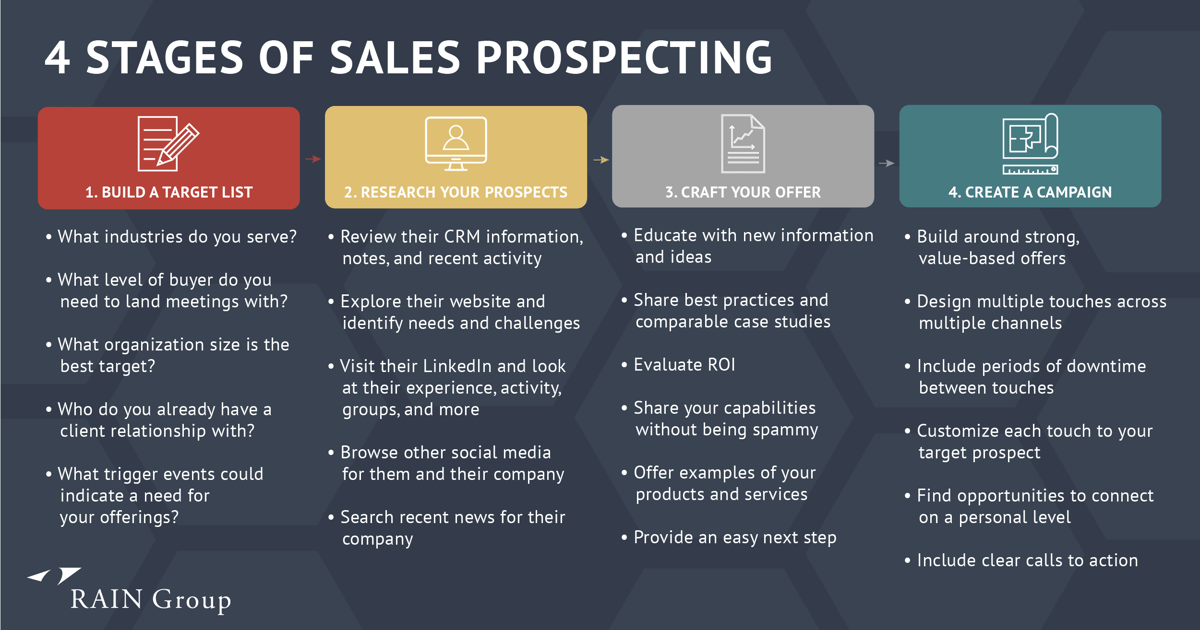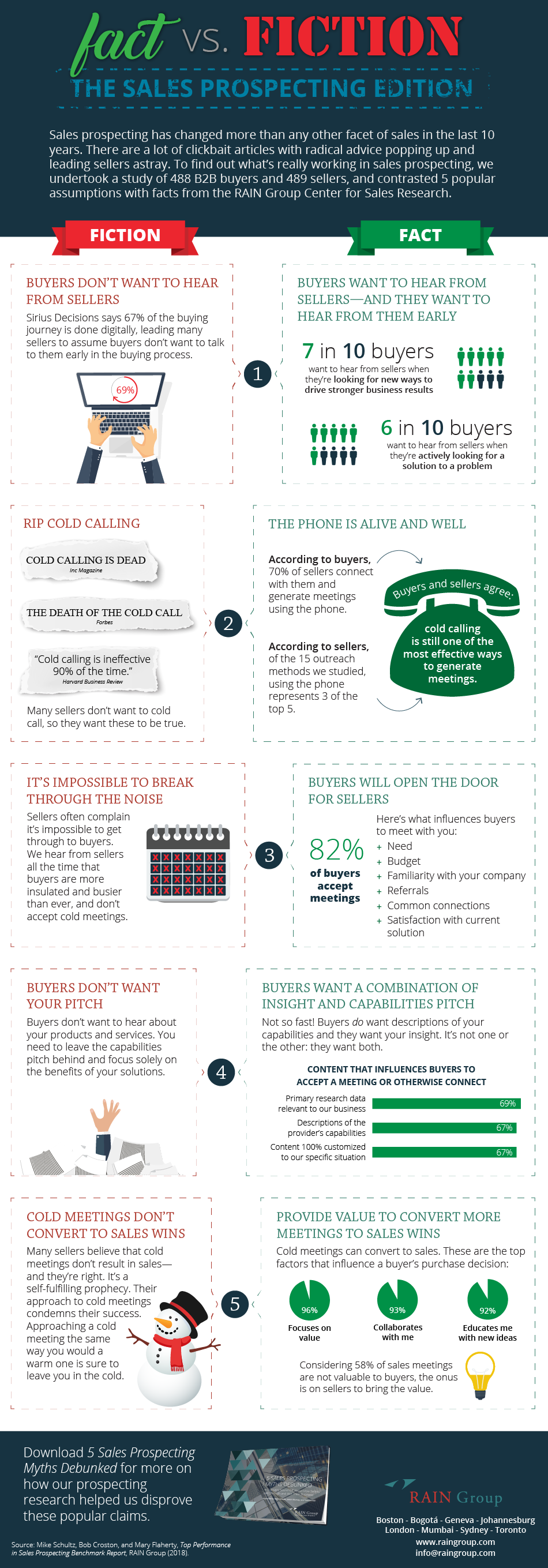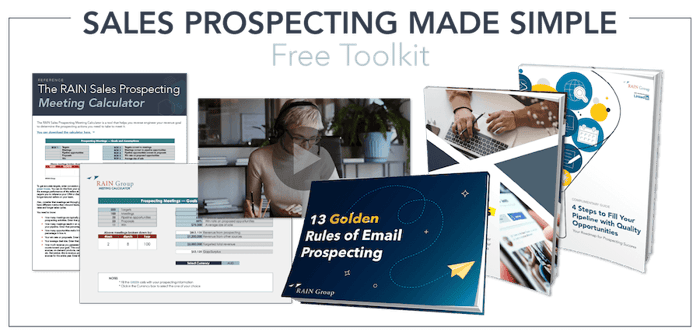What Is Sales Prospecting?
Prospecting is the first stage of the sales cycle in which sellers identify potential buyers. The goal of prospecting is to create interest and then convert that interest into a sales meeting.
The practice of sales prospecting is surrounded by confusion and misconceptions. Prospecting may sound simple enough, but ask a group of sales professionals about the best prospecting approaches and you’re bound to get several conflicting answers.
Most sellers will tell you that creating conversations with prospects is critical to greater success in sales, but the dynamics of how to do it can be baffling.
Download prospecting tools and resources in Sales Prospecting Made Simple. >>
Part of the issue is that different situations rightly call for different approaches, so not all advice is right for every situation. However, our research on Top Performance in Sales Prospecting clearly reveals that the best sales prospectors get results, including setting 2.7x more meetings, achieving their sales goals, and earning higher win rates.
In this article, you'll find tips, processes, and resources to get started on the path to prospecting success.
Your Guide to Prospecting in Sales
Sales Prospecting Strategy
First off, let's take a look at the 4 key strategies used by top performers in sales prospecting that we refer to as WAVE.
- Winner’s Mindset: Mindset drives behavior. Approach prospecting with a positive mindset and you’ll be more likely to be motivated to stick with it. Focus on refining your approach where you can and celebrating your successes
- Attraction Campaign: Think of prospecting as the process of attracting buyers to you. Send an organized sequence of content and messages customized specifically to the buyer over a specific period of time with the intent of generating a sales meeting.
- Value: You must give prospects a compelling, value-based reason to want to interact with you. Every interaction you have with a prospect should be valuable for them.
- Execution: It’s not enough to have a plan; you must execute and commit to it with time, energy, and focus. Our tips below will help you do just that.
Note that I haven't said the goal of prospecting is to find someone currently looking to purchase a particular product or service. For most sellers, this doesn't work.
When prospecting, you'll find people who are already in the desire phase (someone interested in solving a particular problem or purchasing a known type of product or service) or the action phase (someone already in the process of searching for a solution to the problem).
If your approach is only to look for these people, you're in for several rude awakenings:
- You find someone who’s already looking to buy, and they likely have a front-runner in mind. This front-runner isn't you.
- If you don't sell a commodity product or service, it's likely the buyer isn't considering buying what you offer because they don’t know much about it or why it's valuable.
- You find someone who has the desire to solve a problem and hasn’t yet started looking into how to do it. Great! But finding these people will be like finding the proverbial needle in the haystack.
But if you take the WAVE approach and attract the buyer to you, you can capture their interest and make a compelling case for working with you.
Read An Introduction to Using AI in Sales Prospecting. >>
Prospecting Contact Methods
Gone are the days of door-to-door salespeople. For your outreach to work, you’ll need a combination of channels based on your prospecting targets. Methods include:- Phone (cold or warm calls)
- Event appearances (exhibitions, presentations, or networking)
- Referrals
- Social media engagement
- LinkedIn outreach
- Direct mail
The Sales Prospecting Process
Here are 4 ways to get the prospecting process started.

1. Build a Target List
First, ask yourself: who do I want to generate meetings with?
As you think about targeting, you want to get as specific as possible. The world is not a good target. Answer questions like:
- What are the industries we serve?
- What’s the level of buyer I need to generate meetings with?
- Is there a certain size organization that's an ideal target for us?
- Who do I already have relationships with?
- What are the trigger events that could indicate a need for our products and services?
And so on.
Your target list should include...
Existing buyers and accounts
Your existing customers are prime targets for generating new sales discussions. Ask yourself, “Are all of my accounts buying everything they should from me?” The answer is often a resounding no.
In addition, there are often other buying centers and geographies within your existing accounts that are prime targets.
Past buyers
It’s a best practice to stay in touch with past customers—both the organizations and the individuals. When you connect with your buyers on LinkedIn, note when they switch companies. You can also keep track of new individuals in target roles at past customer companies.
Past opportunities
Maybe these buyers didn’t engage with you then, but things are constantly changing. Stay in touch with past opportunities as you reach out.
A LinkedIn study found that 78% of sales professionals were only connected to one person (single-threaded) or not connected at all in the accounts they’re trying to close. Only 7% were multi-threaded, or connected to six or more people in the account. Furthermore, the sellers who adopt a multi-threaded approach were more successful. On average, those sellers focused on new business had a 34% lift in win rate when multi-threaded versus single-threaded into an account.
The data are clear: it pays to connect with multiple individuals from past opportunities and accounts.
Network
You should tap your (and your colleagues’) networks to uncover buyers and referral sources. LinkedIn and other tools allow you to quickly find these connections.
High-value targets
These are organizations that are the ideal fit for you based on your MVP—most valuable prospect—profile. There are many list-building tools that allow you to search, filter, and find prospects by industry, role, company size, geography, and so on. LinkedIn Navigator is an excellent place to start with this functionality.
Decision makers
Sellers often call too low in the organization and try to start a groundswell by working their way up. People are more likely to refer down than refer up. Reach high to the decision makers. Make sure your list is clean and ready to go before you start.
To find the right contact, you’ll need to do research. You're looking to identify decision makers and determine whether you can provide value to their organization. This also gives you the chance to prioritize your prospects based on value and likelihood of your professional relationship developing further. If you can establish rapport early, you set a strong precedent for ensuing conversations.
Your goal is to build a list of names and target companies. Do this before you carry out your campaign so you can focus on reach when you're ready to execute rather than searching for contacts.
Once you know who you’re targeting, you can prioritize and batch them in similar groups—industries, size, geography, relationship—to organize your outreach. If you have hundreds or thousands of targets, set up your campaigns in batches so you can reach similar groups and industries. Batching helps you keep things straight and use information like industry intelligence that would be relevant for outreach across the batch.
2. Research Your Prospects
The most important part of prospecting is ensuring your lead is a good fit. The information you gather in this step will be relevant for building rapport and qualifying your leads. You should be dedicating the most time to this stage of the process. Otherwise, you risk spending time on outreach that falls flat.
Sellers frequently complain that research takes too much time. Often, it’s because they don’t know how much time to spend. Here’s how you can quickly evaluate what’s going on in your prospect’s world:
- Review your CRM information and notes for 30 seconds to 2 minutes. Check if someone else (or you) has spoken to them before, if they’ve visited or downloaded anything on your website, or if any of their colleagues are currently engaging with your company.
- Explore their website for 1 to 5 minutes. Specifically, look at the leadership team, read news and press releases, review financial disclosures, read the “About Us” section, visit careers, and scan their blog. Use this information to make connections and identify pain points, aspirations, and challenges.
- Review LinkedIn for 30 seconds to 3 minutes. They’ll certainly investigate you in the same way. Specifically, look at:
- Their recent activity
- Job history and title changes
- Any group discussions they’ve participated in
- Anything they’ve published or posted
- Their profile
- Experience
- Honors and awards
- School
- Groups
- Skills and endorsements
- Recommendations
- Explore Twitter/X for 1 to 3 minutes. Check the company account and the personal handle of the target. You can also tag your prospects to keep track of them.
- Browse Google News for 1 to 5 minutes. Search for the company name in quotes and click “News” to see where they’ve been mentioned and for what.
When done in conjunction with larger research efforts, this 4–7-minute process can give you information you can use in upcoming prospecting efforts and conversations.
3. Craft Your Offer
Your ultimate offer might be a particular type of software, technical instrument, medical device, pharmaceutical, building material, financial product, operations or marketing plan, or so on. But the interim offers—the offers you make before they buy from you—must be crafted with the utmost care.
Personalize your approach to drive value. Think about your initial offer, and how it might generate a conversation for you. Are you offering new ideas or a return on investment?
Get 6 core offers to use in your sales prospecting efforts. >>
Even if you know exactly how you can best help a prospect, keep your first touch conversational and relevant. Beyond your sales offering, generate value in your outreach by including free resources or services for the prospect.
Reference the problems they’re facing, but don’t go too deep into the specifics of how you can solve them yet. You’re just trying to learn whether they’re a good fit and secure that all-important first meeting.
4. Create the Prospecting Campaign
The days of making a single call or sending one email to a buyer and securing a meeting are over.
Instead, successful outreach requires an Attraction Campaign: a coordinated, multi-touch outreach campaign that includes strong value-based offers and is designed to generate a meeting with a potential buyer.
Getting through to top prospects requires coordinated effort. It takes an average of 8 touches just to reach and generate a meeting (or demo, or other conversion) with a new prospect. And it frequently takes more than that and varies across different industries and company roles.
These touches include a variety of contact methods, including email, phone, social media, and direct mail. Each approach comes with its own pros and cons. For example, emails give prospects a visually appealing pitch that can be forwarded to others but can also be forgotten or lost in the inbox. Use a mix of touches to maximize benefits and minimize downsides.
A coordinated approach means using an alternating sequence of outreach—for example, calls and emails—with periods of downtime between each. These messages should all be unique and customized to your prospect. Avoid clichés, find opportunities to connect on a personal level, and include clear calls to action.
If you schedule multiple outreach attempts and stick to your plan, you’re more likely to see your invested time pay off.
Use these 13 tips for mastering email prospecting
Sales Prospecting Examples: 6 Proven Offers
Discussions with our clients about value typically focus on the reasons buyers ultimately buy from you using the 4 Whys:
- Why act?
- Why now?
- Why us?
- Why trust?
Watch this video for a refresher.
If you want to impress buyers from the start and generate meetings from your sales prospecting efforts, you still need to answer the same questions. Why should they agree to a meeting with you?
Here are six offer strategies that answer these questions. For each offer, we provide an example of an outreach email and point out where the 4 Whys appear in the messaging.
Offer 1: New Ideas
Sellers who drive value for buyers in the form of insights and ideas achieve greater success than those who don't. Our research has confirmed this time and again.
Even now, 64% of buyers tell us that a seller's ability to educate with new ideas and perspectives highly influences their purchase decision (learn the top factors that influence buyer's decisions in our Virtual Selling Skills & Challenges report).
With the new ideas offer, your goal is to both introduce and begin a discussion on an idea. Here's an example of a seller using this approach based on something specific in the buyer's annual report:
Lucas,
Your priority to attract top millennial talent [Why Act] jumped out at me in Davos Co.'s annual report.
We worked with Outtel's HR team to clearly define the "sense of purpose" in their workplace culture. It's an overwhelming differentiator and has resulted in a 20% uptick in accepted offers. [Why Act] Are you exploring this approach?
Let me know if you're interested in our research [Why Us & Why Trust] on why it resonates with top talent. Given that you have several new job openings, this research could be applied immediately [Why Now].
Any chance you're free on the 14th?
Sara
Notice how the first few sentences are customized with something that would matter specifically to this recipient. This is a powerful form of customization using trigger events, which ranked very highly in our research for influencing buyers to accept a meeting. Trigger events are something specific that has happened that creates an opening for a seller to reach out. The more you can use trigger events, the more you'll generate actual meetings.
Offer 2: Best Practice
With the best practice approach, the idea is to share insights on what others are doing and what's working for them to intrigue the buyer to learn more. Here's an example:
Craig,
I noticed in your investor presentation last week you are focusing on lean manufacturing principles. I'm curious to know how you're focusing on reducing equipment downtime at Valeton Energy?
We just completed a major study on the topic [Why Trust]. Of the top 10 most common practices when managing capital-intensive projects in heavy industry, only 3 have a meaningful impact on reducing equipment downtime [Why Act].
Interested?
Ted
Of course, you can only use this approach if you have this kind of research available. If you're at a larger company, you might already have suitable research or knowledge of best practices. If you're at a smaller company, you can share best practices based on curated research and results you've achieved with other clients in similar industries.
Offer 3: Straight Results
The straight results approach focuses on the outcome or return on investment. Here's an example with the return on investment as the focus:
John,
I'm reaching out because I saw you're planning to reorganize your executive team after the merger with BigCo. With the temporary leadership announcements, it also seems that the team is still in flux [Why Now].
Given the shifts in the market such as X and Y [Why Now], we've been changing how we approach senior leader executive search, and we're almost doubling our placement speed while maintaining a 94% 18-month retention rate [Why Act & Why Us].
I thought you might be interested in hearing about what we've changed [Why Act], and how it's panned out. Interested in discussing?
Steve
Offer 4: Capabilities
We all know buyers can find information about your capabilities on the web. Because of this, many sales pundits say, "Don't pitch capabilities as your sales prospecting approach. This information is readily available and not valuable."
However, do you think that executive buyers are sitting at their computers spending hours searching and browsing websites? If so, good luck with that. For the rest of us, the real situation is that buyers often have an imminent need to fill, and even when they go searching for it, it's unlikely they'll find you.
Capabilities was the second most popular response when we asked buyers what content influences their decision to accept a meeting. The key is positioning your capabilities in the right way. When you share your capabilities, you share competencies and skills a buyer might find appealing at just the right time. Here's an example of a capability-focused outreach:
Erik,
Andrea Jones mentioned you've been looking for ways to streamline R&D processes and suggested I reach out. Are you looking into any of the following areas?
- Doubling efficiency by moving to a completely paperless lab environment. [Why Act]
- Detecting and resolving potential deviations in real-time (rather than waiting for data review). [Why Act]
- Cutting down admin time by up to 30% by centralizing all assays and extractions. [Why Act]
I can walk you through how we do this ahead of our presentation at the Roma Life Sciences Virtual Summit next month [Why Now]. You're free to jump on our website, of course, but I'd also love to get your feedback firsthand on how we compare to other CROs out there. Do you have any time to connect this week?
Jessica
Note that we opened with a referral to show that this isn't a spam email. Many capabilities-focused emails are spam. Even if you don't have a referral, lead with value and be intentional, not spammy.
Offer 5: Demonstration
For specific offerings like technology, products, and even consulting, demonstrations can be very powerful. With demonstrations, you showcase or present clear examples of your capabilities and the results you achieve with them. Here's a straightforward example of how to ask someone to let you give them a demonstration:
Subject line: Change your mind in 10 min?
Margot,
I'll keep this short. Your post on TechReview caught my eye, and I couldn't agree more [Why Now]: most enterprise video conferencing platforms are not worth the hype.
I can give you a 10-minute demo of how our platform avoids exactly the 4 pitfalls you described [Why Act]. Are you available on Friday at 10 am?
Charlie
Even as a demonstration, the offer is positioned as driving insight by showing how to avoid the problems of video conferencing that the recipient themselves mentioned in an article.
Offer 6: First Step
The first step approach is all about offering something of value that's easy for a buyer to accept. Maybe it's not a meeting right away, but an invite to an upcoming webinar, a new white paper, or a piece of research. You're providing value with something they can easily say "yes" to and then ask for the meeting in your follow up. For example:
Becky,
I saw on your website your company has 22 openings for technology team members.
I'm reaching out because we have best practices research exclusively for CIO's [Why Act] on how to recruit and develop the highest performing technology teams that we're presenting in an upcoming webinar [Why Now] on September 3.
Or, as a way of introducing ourselves, I'd like to offer a new-hire checklist you can use to speed up the onboarding process.
Tiffany
With this approach, you offer buyers something low risk: a small amount of their time to spend on something they could find immediately valuable.
Sales Prospecting Facts
The world of sales is constantly changing, as is sales prospecting. Part of the reason there’s so much debate about prospecting is because most sellers don't dedicate enough time to it. As a result, outdated misconceptions can undermine your prospecting efforts.
According to 488 buyers (who get prospected to all the time) and 489 sellers who outbound prospect, the following sales prospecting statements are true, going against established conceptions of how to prospect correctly.
Read more about these findings in 5 Sales Prospecting Myths Debunked. >>
1. Prospecting over the phone works
Many sellers don't want to pick up the phone and call their clients—current or past—under the pretense of generating leads. They don't want to cold call. They say buyers don't pick up the phone anymore, so what's the point?
Phone calls represent 3 of the top 5 most effective prospecting tactics according to sellers.
The top 5 prospecting tactics rated very/extremely effective are:
- Making calls to existing clients: 51%
- Making calls to past clients: 37%
- Speaking at events: 32%
- Sending one-to-one customized emails: 31%
- Making phone calls to new contacts (i.e., cold calls): 27%
The phone is also the second most preferred way buyers like to connect with sellers (49% of buyers prefer to connect with sellers over the phone). C-level and VP-level buyers prefer the phone even more (57%).
There's no denying the phone plays an important role in sales prospecting and it's still one of the most effective ways to generate initial sales conversations with buyers.
2. Buyers want to connect with sellers early in the sales process
Of buyers who accept meetings, 71% want to hear from sellers when they're looking for new ideas and possibilities to drive stronger business results. In addition, 62% of buyers who accept meetings want to talk to sellers when they're actively looking for a solution. These are the early stages of the buying process.
Buyers may do their own research, but they still want to hear from you early in the buying process. Rather than sit back and wait for them to call you, bring your ideas to buyers. When you reach out early, you help define the buyer's needs and position yourself as the preferred supplier.
3. Buyers accept meetings with sellers that reach out to them
One of the most common excuses I hear for not prospecting is, "Buyers don't accept cold meetings."
Eighty-two percent of buyers say they accept meetings, at least sometimes, with sellers who reach out to them proactively. It's certainly not easy to set appointments with busy buyers, but it's far from impossible. Most buyers admit they accept initial meetings when sellers reach out proactively. It's what you do and say in that initial connection that influences whether the buyer meets with you.
4. Buyers want insight and to learn about your capabilities
According to buyers, the content that most influences their decision to accept a meeting or otherwise connect includes:
- Primary research data: 69%
- Content 100% customized to our specific situation: 67%
- Descriptions of the provider’s capabilities: 67%
Insight and capabilities capture buyers' attention. While many sellers are told not to pitch their capabilities, buyers want a combination of insight and knowledge of what you can provide.
5. Value converts to sales
It's one thing to get meetings. It's another to generate sales wins.
What factors are likely to influence a buyer's purchase decision? Ninety-six percent of buyers say they're influenced by sellers who focus on the value they can deliver, and 93% are influenced by sellers who collaborate with them.
If you want to get the meeting and eventually get the win, focus on the value in your sales meeting and work with buyers collaboratively.
It's interesting to note most sellers don't do this. Buyers say 58% of their sales meetings don't provide value. There's a huge opportunity here for the sellers who do.
[Infographic] Sales Prospecting: Fact vs. Fiction
We've rounded these facts up into a downloadable graphic. Click to access the PDF.
Improve Your Sales Prospecting
As you think about your own prospecting efforts, take these findings to heart. Forget what you may have been told in the past: buyers want to talk to you, cold prospecting works, and there's a huge opportunity for those sellers willing to invest the time and effort into prospecting.
If you're looking to improve in each of these areas, our RAIN Sales Prospecting training program will give you the skills, tools, and templates you need to fill your pipeline, perfect your outreach messaging, and connect with buyers at higher rates.
Fill Your Pipeline, Land More Meetings, and Master Prospecting
Get step-by-step tools to make sales prospecting approachable in our new toolkit, available now for free. Download now. >>







